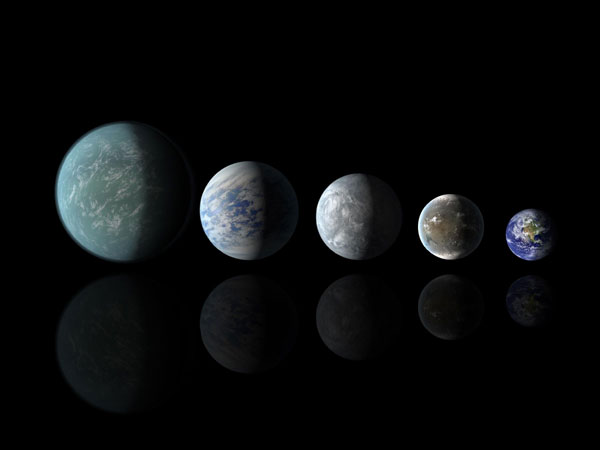NASA telescope's planet-hunting days may be over
Updated: 2013-05-16 11:04
(Xinhua)
|
||||||||
 |
|
Relative sizes of Kepler habitable zone planets discovered as of April 18, 2013 in this artist's rendition provided by NASA. (L to R) Kepler-22b, Kepler-69c, Kepler-62e, Kepler 62f and Earth. Scientists using NASA's Kepler space telescope have found the best candidates yet for habitable worlds beyond the solar system. [Photo/Agencies] |
CAPE CANAVERAL, Fla. - NASA's first telescope dispatched to hunt for Earth-like planets that may support life elsewhere in the universe has lost use of its positioning system, threatening its mission, officials said on Wednesday.
Launched in 2009, the Kepler space telescope revolutionized the study of so-called exoplanets, with discovery of 130 worlds orbiting distant stars and 2,700 potential planets still awaiting confirmation.
The telescope was designed to gaze steadfastly at about 100,000 distant sun-like stars, searching for planets passing by, or transiting, relative to its line of sight. Detecting slight dips in the amount of light from a planet crossing the face of its parent star requires extremely precise pointing.
The telescope, the cornerstone of a $650 million mission, lost that ability on Tuesday when a second steadying spinning wheel stopped working.
The telescope needs at least three of its four wheels operating to hunt for planets. It lost use of its first wheel last year.
"It certainly is not good news for the mission, which has been performing so well and had so much promise for doing even better," deputy project manager Charles Sobeck, with NASA's Ames Research Center, told reporters during a hastily arranged conference call on Wednesday.
The telescope is orbiting about 40 million miles (64 million km) from Earth, too far for a robotic or astronaut-led repair mission, added John Grunsfeld, NASA's associate administrator for science.
"We're not ready to call the mission over, but by any measure this has been a spectacularly successful mission," Grunsfeld said.
In addition to trying to get the failed wheel working, engineers and scientists will be looking for alternative ways of operating the telescope.
They also will assess if Kepler could be used for other types of astronomical observations which do not require such precise pointing.
The goal of the mission is to find Earth-sized planets located the proper distance from their parent stars so they would have the right temperatures for liquid surface water. Water is believed to be necessary for life.
Though the telescope currently isn't collecting any data, scientists have years of archived observations still to analyze.
"The mission was designed for four years. It operated four years. It gave us excellent data for four years. So I'm very delighted," said Kepler lead scientist William Borucki, with NASA's Ames Research Center in Moffett Field, California.
"I would have been even happier if it continued another four years because we'd have better data about more stars, about smaller planets and we'd have more planets that we'd probably find in the habitable zone," Borucki said.
"That would have been, in some sense, frosting on the cake, but we have an excellent cake right now," he said.

 Michelle lays roses at site along Berlin Wall
Michelle lays roses at site along Berlin Wall
 Historic space lecture in Tiangong-1 commences
Historic space lecture in Tiangong-1 commences
 'Sopranos' Star James Gandolfini dead at 51
'Sopranos' Star James Gandolfini dead at 51
 UN: Number of refugees hits 18-year high
UN: Number of refugees hits 18-year high
 Slide: Jet exercises from aircraft carrier
Slide: Jet exercises from aircraft carrier
 Talks establish fishery hotline
Talks establish fishery hotline
 Foreign buyers eye Chinese drones
Foreign buyers eye Chinese drones
 UN chief hails China's peacekeepers
UN chief hails China's peacekeepers
Most Viewed
Editor's Picks

|

|

|

|

|

|
Today's Top News
Shenzhou X astronaut gives lecture today
US told to reassess duties on Chinese paper
Chinese seek greater share of satellite market
Russia rejects Obama's nuke cut proposal
US immigration bill sees Senate breakthrough
Brazilian cities revoke fare hikes
Moody's warns on China's local govt debt
Air quality in major cities drops in May
US Weekly

|

|







